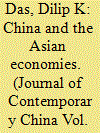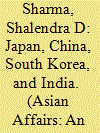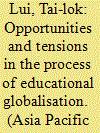| Srl | Item |
| 1 |
ID:
124167


|
|
|
|
|
| Publication |
2013.
|
| Summary/Abstract |
The objective of this article is to explore the economic relationship between China and the surrounding dynamic Asian economies. It delves into China's influence over the Asian economies and whether this relationship has evolved in a market- and institution-led symbiotic manner. The three principal channels of regional integration analyzed in this article are trade, FDI and vertically integrated production networks. Another issue that this article explores is the so-called China 'threat' or 'fear' in Asia. The China threat implied that China was crowding out exports from the other Asian economies in the world market place. Also, as China became the most attractive FDI destination among developing countries, it was understood that China was receiving FDI at the expense of the Asian economies. These concerns were examined by several empirical studies and the inference was that they were exaggerated. The article concludes that China methodically expanded and deepened its economic ties with its regional neighbors. At the present juncture, China's integration with the surrounding Asian nations is deep. Both China and its dynamic Asian neighbors have benefited from this synergy.
|
|
|
|
|
|
|
|
|
|
|
|
|
|
|
|
| 2 |
ID:
151143


|
|
|
|
|
| Summary/Abstract |
This research aims to examine the sophistication of export portfolios of selected Association of South East Asian Nation (ASEAN) and developed Asian economies. It aims to provide evidence of where exactly ASEAN economies are in the context of exports sophistication and structural transformation. Results from a product space analysis indicate that although limited in product scope, there are prospects for ASEAN economies to converge to the level of export sophistication of developed Asian countries. The analysis finds a need for governments to take a more active role in promoting more appropriate industrial and economic policies.
|
|
|
|
|
|
|
|
|
|
|
|
|
|
|
|
| 3 |
ID:
137597


|
|
|
|
|
| Summary/Abstract |
Based on the convergence hypothesis and referring to the experience of East Asian high-performing economies from 1950 to 2010, this paper projects and plots the potential growth rate of the Chinese economy over the next 20 years. It predicts that the potential growth rate of per capita GDP adjusted by purchasing power parity averages at 6.02 percent from 2015 to 2035, while the potential GDP growth rate of 2015 would still be above 8 percent, which implies that the realized rate of growth has not reached its potential since 2012. Besides, based on the per capita GDP projected and on cross-country comparison, the paper plots the trajectory of structural change of the Chinese economy from 2015 to 2035. The result shows that: (i) the value-added share of primary industry will drop more rapidly than the employment share; (ii) the value-added share of secondary industry will decline and employment share will present an inverted U shape whose turning point will probably come between 2020 and 2025; (iii) both the value-added and employment share of tertiary industry will increase continuously.
|
|
|
|
|
|
|
|
|
|
|
|
|
|
|
|
| 4 |
ID:
181474


|
|
|
|
|
| Summary/Abstract |
The government intervention directly achieves the strategic variation of industrial sector. Following this, the current study analyzes the impact of government concerns for green environment on investment decisions of industrial sector and how this effect changes across the countries that have developed financial sector. The sample size consists of financial statistics for the year 2007–2016 of non-financial sector firms from 11 selected economies of Asia. We employ panel EGLS (estimated generalized least square) and two-step system GMM (generalized method of moments) model due to problem of heteroskedasticity and endogeneity relatively. The statistical outputs of both models imply that carbon taxation has a negative impact while other green environmental strategies i.e., renewable energy utilization, production of electricity from renewable energy sources, and green growth productivity positively and significantly influence real investment decisions. Additionally, the statistical analysis illustrates the moderating impact of financial sector development on aforementioned relationship. The current analysis corroborates the thoughts of Porter's hypothesis and direct the important policy recommendations regarding environmental policies and their dynamical role in industrial sector investment decisions. Industrial sector should transform its energy needs from conventional energy production sources to renewable energy production due to positive impacts of renewable sources on investment.
|
|
|
|
|
|
|
|
|
|
|
|
|
|
|
|
| 5 |
ID:
101755


|
|
|
| 6 |
ID:
134159


|
|
|
|
|
| Publication |
2014.
|
| Summary/Abstract |
With the rise of Asian economies, university education in the region is no longer just a service to be consumed domestically. It is also perceived as an industry for a rising global city. How to capture the growing market and make the best use of such an opportunity for city building is now on the agenda of many cities in Asia. Hong Kong is a particularly interesting case as it is both a destination for many talented students from China and a bridge for international students to reach different parts (China in particular) of Asia. Educational globalisation seems to make sense politically as well as economically. Yet how to strike a balance between opening the door of universities to the outside world and meeting the education needs of the local population is by no means unproblematic. At stake are further changes in the universities, and major challenges to the political capacity of the government which has to turn higher education into a revenue generating service without doing it at the expense of local interests.
|
|
|
|
|
|
|
|
|
|
|
|
|
|
|
|